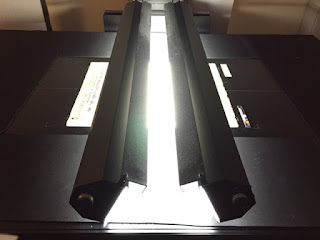Hello! My name is Emilie Duncan,
and I am the new graduate book conservation intern in Eliza’s lab at UVa. I am
a third year fellow in the
Winterthur/University of Delaware Program in ArtConservation, and as such, will be completing a yearlong internship here.
Designed as a practical, hands-on follow up to my first two years, the
internship will involve treatment of both special collections and circulating
library books and archival documents, participation in general preservation
activities such as exhibit prep and pest management, and generally getting my
feet wet with book conservation in the “real world.”
At the close of my third week here,
I already have lined up some exciting and fascinating projects. Three weeks
spent “lining up” projects? You might think I have not been using my time
wisely, but there is a lot that goes into a conservation treatment before the
actual treatment even begins.
The
first step is careful examination and consideration of the object at hand,
including its materials, construction methods, and current condition problems.
All of this information is necessary to plan out a treatment that will
effectively and safely stabilize its condition and make it accessible to
researchers. For example, in my first week, I was presented with a large box of
maps and broadsides that had been stashed away by a former stacks manager
because they were in need of some sort of treatment before being housed in the library stacks. One of the details
that I recorded during my examination was media type and print process. Knowing
what materials are present can help determine what treatment methods are
possible. The oil- and pigment-based lithographic printing ink used on the bulk
of the objects is not sensitive to water-based treatments, such as bathing.
However, the poor-quality iron gall ink inscription at the bottom of one of the
broadsides may include added ingredients that could wash away during aqueous
treatment, so thorough testing will need to be carried out in order to ensure
that the treatment does not alter the document in a negative way.
Another important factor to consider before
proposing a treatment is the historical and material context of the object.
This information can help to understand construction and condition aspects of
the object as it exists today, as well as aid in determining specific goals of
a treatment. A good example is another one of my upcoming projects, an early
copy of Francis Bacon’s Sylva Sylvarum
(an exhaustive natural history record published shortly after his death in
1626). I say “early copy” because the book is lacking the title page (and the
front board, and most of its spine… but that is less relevant at this point)
which contains the date of publication. It would be fairly easy to just look up
the publication date of the book, but that is complicated by the fact that the
book was republished in almost 20 editions in the 17th century
alone, and without the title page it can be tricky to determine which edition I
am looking at. However, in comparing the text with other copies of other
editions in the special collections, and with images of other editions
available online, I began to parse out the small differences that set the
various books apart. During the hand press period, individual pieces of metal
type were arranged by hand to print each sheet of text. Even if the same type
was used and arranged the same way for different editions, small differences
can be seen.See the picture below with the 1626 edition on the left and the 1631 on the right.
 |
| The red arrow points to the switched orientation of the type used in the border. Note the different catchwords in the yellow boxes. |
Using this
method, I was able to determine that the book was either a first edition (1626)
or a reissue of the first edition (1627). (“Reissue” meaning the book was put
on sale again without re-setting the type or making changes to the text – which
could constitute a new “edition.”) The only difference between the 1626 version
and the 1627 version is the addition of a fancy, engraved title page, in addition to the
original, plain, letterpress title page (which still reads 1626). The reason for these variations, or any clues to which year the copy in the Small Special
Collections was published, is still eluding me. Further
research and a possible trip up to the Folger to look at some other 1626/7
copies will hopefully shed some light on this soon. I’ll keep you posted!
All the condition and contextual information,
along with a step-by-step proposal based on what I see when I look closely at
each object, is recorded systematically in an assessment/treatment proposal
document. This document serves both as a guide for the conservator during
treatment and as a reference point for discussion with the curator, who will
determine if the proposed treatment aligns with the research goals for the
object.
Next, the object is photographed to
record its condition and unique features before treatment. Usually, this is
done on a copy stand for books and documents. However, many of the maps and
broadsides I will be treating were too big, so they were done on the
Digitization Production Group’s Cruse scanner. The images collected by the
flatbed scanner are so high-quality that each scan takes about 10 minutes to
complete!
After all this, the objects are
finally ready to treat, and I hope to dive in on that step starting next week.
 For local treatment, we use pieces of Gortex, layered with damp blotter to provide just enough humidification to soften paper in the area around the crease and then drying under weights so that everything dries flat.
For local treatment, we use pieces of Gortex, layered with damp blotter to provide just enough humidification to soften paper in the area around the crease and then drying under weights so that everything dries flat. 






